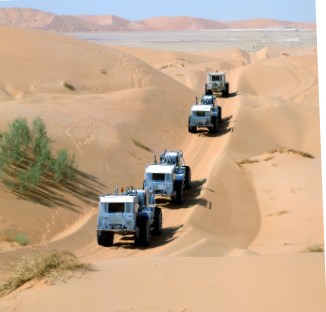
Paul R Wood* looks at how explorationists today use cutting edge technology to visualise the subsurface in 3D.
Geoscientist 17.9 September 2007
The goals of geologists and geophysicists engaged in the exploration and extraction of oil and gas resources are similar to those of many geoscientists. They need to develop models of the Earth, ranging from the scale of geological basins that may be thousands of square kilometres in size, to detailed and accurate descriptions of individual hydrocarbon reservoirs, often on a sub-metre scale.
Traditional geological mapping relies on regular sampling of surface outcrops, analysis of the clues presented by them of the structure and evolution of the strata, and interpolation of the data to provide three-dimensional maps and Earth models. This is also the task of geoscientists in energy companies, but the interpolation can take them to thousands of metres depth, or far offshore , hundreds of kilometres from any outcrop.
Applying traditional geology is, of course, part of this task, and rock samples and data from great depths or where there are no outcrops can be taken from boreholes, many of them drilled as exploration or development wells by the oil and gas industry. However, even these wells cannot give the detail of spatial sampling we require. For many years the most common method used in the industry to help build Earth models has been to conduct seismic reflection surveys. Acoustic impulses are generated at the surface by compressed air at sea, or special trucks (Vibroseis
TM) on land. The signals are reflected by subsurface strata and measured by surface detectors that convert them to electronic data and record them on magnetic tape. Computer processing of the data then reveals the subsurface structure and properties of the rocks such as their density and the speed of the acoustic waves transmitted through them. From these we can infer other characteristics such as porosity, pressure, and in some cases the type of fluid contained in the pore spaces.
3D seismic surveys
Before the 1970s, seismic surveys were acquired as a series of profiles – usually straight traverses across the surface that yielded two-dimensional cross-sections of the Earth (2D seismic). Such surveys are still conducted today over large areas in order to develop models at geological basin scale. The accuracy of the models depends on the spacing of the traverses – closer spacing incurring higher costs. Over the past 40 years, however, three-dimensional survey methods have been developed (3D seismic). On land we deploy the acoustic signal (source) and detector (receiver) profiles in orthogonal directions. At sea, specially equipped seismic vessels tow multiple sets of sources and receivers simultaneously. By covering a surface area with the survey, a three-dimensional image of the Earth beneath can be generated. This gives more detailed sampling than is possible with 2D, and additional computer processing can make the image more accurate.